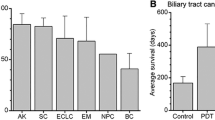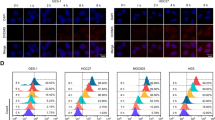Abstract
Our recent investigation uncovered that the acid ceramidase inhibitor LCL521 enhances the direct tumor cell killing effect of photodynamic therapy (PDT) treatment. The present study aimed at elucidating the mechanisms underlying this effect. Exposing mouse squamous cell carcinoma SCCVII cells treated with temoporfin-based PDT to LCL521 (rising ceramide concentration) produced a much greater decrease in cell survival than comparable exposure to the sphingosine kinase-1 inhibitor PF543 (that reduces sphingo-sine-1-phosphate concentration). This is consistent with recognizing the rising levels of pro-apoptotic sphingolipid ceramide as being more critical in promoting the death of PDT-treated cells than the reduction in the availability of pro-survival acting sphingosine-1 phosphate. This pro-apoptotic impact of LCL521, which was suppressed by the apoptosis inhibitor bongkrekic acid, involves the interaction with the cellular stress signaling network. Hence, inhibiting the key elements of these pathways markedly influenced the adjuvant effect of LCL521 on the PDT response. Particularly effective was the inositol-requiring element-1 (IRE1) kinase inhibitor STF-083010 that dramatically enhanced the killing of cells treated with PDT plus LCL521. An important role in the survival of these cells was exhibited by master transcription factors STAT3 and HIF-1α. The STAT3 inhibitor NSC 74859 was especially effective in further reducing the cell survival rates, suggesting its possible exploitation for therapeutic gain. An additional finding in this study is that LCL521-promoted PDT-mediated cell killing through ceramide-mediated lethal effects is extended to the interaction with other cancer treatment modalities with a rapid cellular stress impact such as photothermal therapy (PTT) and cryoablation therapy (CAT).
Similar content being viewed by others
References
P. Agostinis, K. Berg, K. A. Cengel, T. H. Foster, A. W. Girotti, S. O. Gollnick, S. M. Hahn, M. R. Hamblin, A. Juzeniene, D. Kessel, M. Korbelik, J. Moan, P. Mroz, D. Nowis, J. Piette, B. C. Wilson and J. Golab, Photodynamic therapy of cancer: an update, CA Cancer J. Clin., 2011, 61, 250–281.
T. J. Dougherty, C. J. Gomer, B. W. Henderson, G. Jori, D. Kessel, M. Korbelik, J. Moan and Q. Peng, J. Natl. Cancer Inst., 1998, 90, 889–905.
M. Korbelik, Role of cell stress signaling networks in cancer cell death and antitumor immune response following proteotoxic injury inflicted by photodynamic therapy, Lasers Surg. Med., 2018, 50, 491–498.
I. B. Hernandez, Y. Yu, F. A. Ossendorp, M. Korbelik and S. Oliviera, The immune response triggered in oncologic photodynamic therapy: clinical recommendations, J. Clin. Med., 2020, 9(2), 333, DOI: 10.3390/jcm9020333.
M. Korbelik, J. Banáth, W. Zhang, P. Gallagher, T. Hode, S. S. K. Lam and W. R. Chen, N-dihydrogalactochitosan as immune and direct antitumor agent amplifying the effects of photodynamic therapy and photodynamic therapy-generated vaccines, Int. Immunopharmacol., 2019, 75, 105764.
M. Korbelik, J. Banath, W. Zhang, K. M. Saw, Z. M. Szulc, A. Bielawska and D. Separovic, Interaction of acid ceramidase inhibitor LCL521 with tumor response to photodynamic therapy and related vaccine, Int. J. Cancer, 2016, 139, 1372–1378.
M. Korbelik, Sphingolipid activity in oxidative stress response and tumor immunity, Austin J. Vaccines Immunother., 2016, 3(1), 1008.
F. Liu, X. Li, C. Lu, A. Bai, J. Bielawski, B. Marshall, P. V. Schoenlein, I. O. Kebedyeva and K. Liu, Ceramide activates lysosomal cathepsin B and cathepsin D to attenuate autophagy and induces ER stress to suppress myeloid-derived suppressor cells, Oncotarget, 2016, 7, 83907–83925.
D. Separovic, J. Bielawski, J. S. Pierce, A. L. Tarca, B. Ogretmen and M. Korbelik, Increased tumour dihydro-ceramide production after Photofrin-PDT alone and improved tumour response after the combination with the ceramide analogue LCL29. Evidence from mouse squamous cell carcinoma, Br. J. Cancer, 2009, 100, 626–632.
M. Korbelik, W. Zhang, K. M. Saw, Z. M. Szulc, A. Bielawska and D. Separovic, Cationic ceramides and analogues, LCL30 and LCL85, as adjuvants to photodynamic therapy of tumors, J. Photochem. Photobiol., B, 2013, 126, 72–77.
D. Separovic, P. Breen, N. B. Boppana, E. van Buren, N. Joseph, J. M. Kraveka, M. Rahmaniyan, L. Li, T. I. Gudz, A. Bielawska, A. Bai, J. Bielawski, J. S. Pierce and M. Korbelik, Increased killing of SCCVII squamous cell carcinoma cells after the combination of Pc 4 photodynamic therapy and dasatinib is associated with enhanced caspase-3 activity and ceramide synthase 1 upregulation, Int. J. Oncol., 2013, 43, 2064–2072.
T. Yabu, H. Shiba, Y. Shibasaki, T. Nakanishi, S. Imamura, K. Touhata and M. Yamashita, Stress-induced ceramide generation and apoptosis via the phosphorylation and activation of nSMase by JNK signalling, Cell Death Differ., 2015, 22, 258–273.
R. Nganga, N. Oleinik and B. Ogretmen, Mechanisms of ceramide-dependent cancer cell death, Adv. Cancer Res., 2018, 140, 1–25.
D. Khurana, E. A. Martin, J. L. Kasperbauer, B. W. O’Malley, D. R. Salomao, L. Chen and S. E. Strome, Characterization of a spontaneously arising murine squamous cell carcinoma (SCC VII) as a prerequisite for head and neck cancer immunotherapy, Head Neck, 2001, 23, 899–906.
A. Bai, Z. M. Szulc, J. Bielawski, J. S. Pierce, B. Rembiesa, S. Terzieva, C. Mao, R. Xu, B. Wu, C. J. Clarke, B. Newcomb, X. Liu, J. Norris, Y. S. Hannun and A. Bielawska, Targeting (cellular) lysosomal acid ceramidase by B13: Design, synthesis and evaluation of novel DMG-B13 ester prodrugs, Bioorg. Med. Chem., 2014, 22, 6933–6944.
M. Korbelik, J. Banáth, W. Zhang, T. Hode, S. S. K. Lam, P. Gallagher, J. Zhao, H. Zeng and W. R. Chen, N-dihydro-galactochitosan-supported tumor control by photothermal therapy and photothermal therapy-generated vaccine, J. Photochem. Photobiol., B, 2020, 204, 111780.
Y. A. Hannun and L. M. Obeid, Principles of bioactive lipid signaling: lessons from sphingolipids, Nat. Rev. Mol. Cell Biol., 2008, 9, 139–150.
D. Shida, K. Takabe, D. Kapitanov, S. Milstein and S. Spiegel, Targeting SphK1 as a new strategy against cancer, Curr. Drug Targets, 2008, 9, 662–673.
J. C. Cheng, A. Bai, T. H. Beckham, S. T. Marrison, C. L. Yount, K. Young, P. Lu, A. M. Bartlett, B. X. Wu, B. J. Keane, K. E. Armeson, D. T. Marshall, T. E. Keane, M. T. Smith, E. E. Jones, R. R. Drake Jr., A. Bielawska, J. S. Norris and X. Liu, Radiation-induced acid ceramidase confers prostate cancer resistance and tumor relapse, J. Clin. Invest, 2013, 123, 4344–4358.
M. E. Schnute, M. D. McReynolds, T. Kasten, M. Yates, G. Jerome, J. W. Rains, T. Hall, J. Chrenick, M. Kraus, C. N. Cronin, M. Saabye, M. K. Highkin, R. Broadus, S. Oqawa, K. Cukyne, L. E. Zawadzke, V. Peterkin, K. Ivanar, J. A. Scholten, J. Wendling, H. Fujiwara, O. Nemirovskiy, A. J. Wittwer and M. M. Nagiec, Modulation of cellular S1P levels with a novel, potent and specific inhibitor of sphin-gosine kinase-1, Biochem. J., 2012, 444(1), 79–88.
N. B. Bopanna, U. Stochaj, M. Kodiha, A. Bielawska, J. Bielawski, J. S. Price, M. Korbelik and D. Separovic, C6-pyridinium ceramide sensitizes SCC17B human head and neck squamous cell carcinoma cells to photodynamic therapy, J. Photochem. Photobiol., B, 2015, 143, 163–168.
K. Dodo, M. Katoh, T. Shimizu, M. Takahashi and M. Sodeoka, Inhibition of hydrogen peroxide-induced necrotic cell death with 3-amino-2-indoIyImaIeimide derivatives, Bioorg. Med. Chem. Lett., 2005, 15, 3114–3118.
H. S. Yoon, S. C. Moon, N. D. Kim, B. S. Park, M. H. Jeong and Y. H. Yoo, Geinstein induces apoptosis of RPE-J cells by opening mitochondrial PTP, Biochem. Biophys. Res. Commun., 2000, 276, 151–156.
I. Papandreu, N. C. Denko, M. Olson, H. Van Melckebeke, S. Lust, A. Tam, D. E. Solow-Cordero, D. M. Bouley, F. Offner, M. Niwa and A. C. Koong, Identification of an IRE1alpha endonuclease specific inhibitor with cytotoxic activity against human multiple myeloma, Blood, 2011, 117, 1311–1314.
H. P. Harding, A. F. Zyryanova and D. Ron, Uncoupling proteostasis and development in vitro with a small molecule inhibitor of pancreatic endoplasmic reticulum kinase, PERK, J. Biol. Chem., 2012, 287, 44338–44344.
C. Sidrauski, D. Acosta-Alvear, A. Khoutorsky, P. Vedantham, B. R. Hearn, K. Gamache, C. M. Gallagher, K. K. Ang, C. Wlison, V. Okreglak, A. Ashkenazi, B. Hann, K. Nader, M. R. Arkin, A. R. Benslo, N. Sonenberg and P. Walter, Pharmacological brake-release of mRNA translation enhances cognitive memory, eLife, 2013, e00498.
B. G. Hoffstrom, A. Kaplan, R. Letso, R. S. Schmid, G. J. Turmel, D. C. Lo and B. R. Stockwell, Inhibitors of protein disulfide isomerase suppress apoptosis induced by misfolded proteins, Nat. Chem. Biol., 2010, 6, 900–906.
C. Grek and D. M. Townsend, Protein disulfide isomerase superfamily in disease and regulation of apoptosis, Endoplasmic Reticulum Stress Dis., 2014, 1, 4–17.
M. Pajares, A. Cuadrado and A. I. Rojo, Modulation of proteasis by transcription factor NRF2 and impact in neurode-generative diseases, Redox Biol., 2017, 11, 543–553.
A. Batista, J. J. Rodvold, S. Xian, S. C. Searles, A. Lew, T. Iwawaki, G. Almanza, T. C. Waller, J. Lin, K. Jepsen, H. Carter and M. Zanetti, IRE1α regulates macrophage polarization, PD-L1 expression, and tumor survival, PLoS Biol., 2020, 8(6), e3000687.
J. Li, Y.-Q. Yuan, L. Zhang, H. Zhang, S.-W. Zhang, Y. Zhang, X.-X. Xuan, M.-J. Wang and J.-Y. Zhang, Exogenous hydrogen sulfide protect against high glucose-induced apoptosis and oxidative stress by inhibiting the STAT3/HIF-1α pathway in H9c2 cardiomiocytes, Exp. Ther. Med., 2019, 18, 3948–3958.
L. Qiao, C. Xu, Q. Li, Z. Mei, X. Li, H. Cai and W. Liu, Photodynamic therapy activated STAT3 associated pathways: Targeting intrinsic apoptotic pathways to increase PDT efficacy in human squamous carcinoma cells, Photodiagn. Photodyn. Ther., 2016, 14, 119–127.
S. Mitra, S. E. Cassar, D. J. Niles, J. A. Puskas, J. G. Frelinger and T. H. Foster, Photodynamic therapy mediates the oxygen-dependent activation of hypoxia-inducible factor 1α, Mol. Cancer Ther., 2006, 5, 3268–3274.
K. Siddiquee, S. Zhang, W. C. Guida, M. A. Blaskovich, B. Greedy, H. R. Lawrence, M. L. Yip, R. Jove, M. M. McLaughlin, N. J. Lawrence, S. M. Sebti and J. Turkson, Selective chemical probe inhibitor of Stat3, identified through structure-based virtual screening, induces antitumor activity, Proc. Natl. Acad. Sci. U. S. A., 2007, 104, 7391–7396.
K. Lee, J. E. Kang, S.-K. Park, Y. Jin, K.-S. Chung, H.-M. Kim, K. Lee, M. R. Kang, M. K. Lee, K. B. Song, E.-G. Yang, J.-J. Lee and M. Won, LW6, a novel Hif-1 inhibitor, promotes proteosomal degradation of HIF-1α via upre-gulation of VHL in as colon cancer cell line, Biochem. Pharmacol., 2010, 80, 982–989.
F. Zhou, X. Li, M. F. Naylor, T. Hode, R. E. Nordquist, L. Alleruzzo, J. Baker, S. S. K. Lam, N. Du, L. Shi, X. Wang and W. R. Chen, InCVAX –a novel strategy for treatment of late-stage metastatic cancers through photoimmunotherapy induced tumor-specific immunity, Cancer Lett., 2015, 359, 169–177.
R. I. Cazzato, J. Garnon, N. Ramamurthy, G. Koch, G. Tsoumakidou, J. Caudrelier, F. Argioni, L. Zugaro, A. Barile, C. Masciocchi and A. Gang, Percutaneous image-guided cryoablation: current applications and results in oncologic field, Med. Oncol., 2016, 33, 140.
Author information
Authors and Affiliations
Corresponding author
Rights and permissions
About this article
Cite this article
Korbelik, M., Zhao, J., Zeng, H. et al. Mechanistic insights into ceramidase inhibitor LCL521-enhanced tumor cell killing by photodynamic and thermal ablation therapies. Photochem Photobiol Sci 19, 1145–1151 (2020). https://doi.org/10.1039/d0pp00116c
Received:
Accepted:
Published:
Issue Date:
DOI: https://doi.org/10.1039/d0pp00116c




